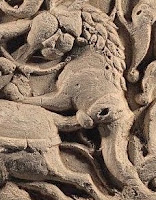 |
| Plaster Relief |
Plaster
Relief
Plaster Relief in the Museum of Turkish and Islamic Art, Sultanahmet,
was made with moulded plaster by stucco technic. It belongs to period of Anatolian
Seljuq (or Seljuk) and found in Konya, Turkey. This is one of the hunting
scenes which exists a farreaching number in the craft of the Anatolian
Seljuq's. Elaborate contemplations propose a date of the 7th-8th and 13th-14th
centuries.
 |
| Stars and Polygons in Plaster Relief |
Middle area of the frieze delineates two
horsemen in fight with a dragon and a lion. The wide upper fringe contains a
geometric organization of interlocking stars and polygons, while blanks in the
primary surface is filled with a botanical arrangement including spiraling
rings and palmettes besides figures.
 |
| Lion in Plaster Relief |
Main part of the relief are filled with a
representation of two horsemen depicted while confronting each other. The one
on the left has been presented charging in order to kill the dragon, while the
one on the right side was murdering the lion. Dresses and facial composes of
both figures, are distinctively Seljuq. Animal figures such as stallions, lion
and dragon, symbolize the devotion to nature. Additionally, the way of horseman
pivots in the seat to push his sword into the lion, attributes the scene a
dynamic air.
Asian or Christian Interaction?
 |
| Dragon in Plaster Relief |
The depiction of a horseman
killing a mythical beast was a famous subject in Anatolia in the Seljuq period
and also previously. Epic scenes of Saint George murdering the dragon were
delineated likewise in Christianity. However, the dragon which is a constant
figure in pagan religions and old myths, could had been Christianized just like
cross and other elements concerning paganism, yet it is still a dilemma that
Seljuq Turks met dragon figure through Chinese culture which their ancient
ancestors Huns had been neighbour to once, or through the Christian factors
just like the Cappadocian Saint George.




 Reviewed by Articonog
on
December 29, 2019
Rating:
Reviewed by Articonog
on
December 29, 2019
Rating:
 Reviewed by Articonog
on
December 29, 2019
Rating:
Reviewed by Articonog
on
December 29, 2019
Rating:





No comments: